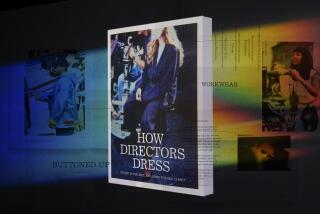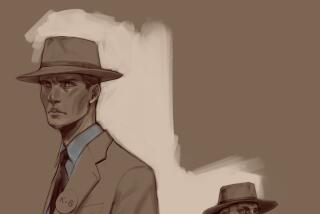Ski-Wear Designer Looks Down the Slope to Next Season’s Looks
- Share via
While skiers fret about the lack of snow on Southern California slopes this winter, ski-wear designer Susie Wiyninger already has her sights on next year’s ski season and beyond.
As head designer for ski-wear manufacturer Nils Inc. in Fountain Valley, Wiyninger has to predict what skiers will want to wear a year or even two years ahead of time. For any fashion designer, forecasting trends that far in advance is as challenging as a double black diamond run.
On this day in January, Wiyninger sits at her desk putting the finishing touches on the final two sketches of the 1996-97 Nils collection, to be unveiled Feb. 1.
“I’m going to open a bottle of champagne as soon as I’m done,” she says.
Wiyninger won’t have long to celebrate. As soon as the collection debuts, she’ll begin choosing the palette for her 1997-98 groups. Unlike ready-to-wear fashions, which change seasonally, ski wear comes out just once a year, so Wiyninger has only one shot at picking the hot new ski looks.
“It’s the hardest part about my job to forecast so far ahead,” Wiyninger says. “It’s so scary--will skiers want shiny fabrics? Bright colors? I have to be this genie.”
Some would say that Wiyninger is part genie.
For 10 years, the 46-year-old Newport Beach resident has made magic for Nils, helping the line expand to more than 500 retailers in the United States, Europe, New Zealand and Canada.
Wiyninger’s most recent trick has been to conjure up a successful apres-ski line for Nils. Launched last year, the new fleece collection had double the anticipated orders and was picked up by Nordstrom and other department stores.
Wiyninger designed coats, vests and jackets made of sheared, synthetic “polar fur,” stirrup pants of stretch corduroy and velvet and sweaters, all of which can be worn by nonskiers vacationing in cold weather or relaxing at the lodge.
“It’s not as technical, which makes it more fun for me,” Wiyninger says. Designing ski wear requires working with high-tech fabrics and complicated construction. One insulated ski suit can require 120 pattern pieces.
During her long run with Nils, Wiyninger has seen ski wear go from functional to fashion-conscious.
“The ski-wear market has moved up in price points. There are people in their 30s to 60s putting out money” for expensive parkas and ski pants, she says.
Wiyninger has helped Nils satisfy the “woman who wants to be elegant but doesn’t want to spend $800 or $900 on a ski suit.” (The company’s upper-end ski suits are no more than $600, and the jackets top out around $400.)
She’s put skiers into lush, silky fabrics, velvet trims and faux and real fur. Ten years ago she created the flattering stretch-bottom ski suit that has become a ski-wear staple. She’s also brought high-fashion colors to the slopes.
“We’re known for our fabrics and colors. Designing fabrics is my favorite part of the job,” she says.
Nils’ 1996-97 collection features faux suedes, shimmering cross-dyed metallics and silky microfibers. The fabrics come in rich hues, including brights like fuchsia, jewel tones and deeper neutrals such as cappuccino and mocha. Some of the coats and jackets have faux leopard or shearling collars and cuffs, or genuine black fox fur.
“Color is the biggest story. Everything before was black, black, black,” Wiyninger says.
The City of Lights group was inspired by Chanel and features black piping and Chanel-style snaps on bright jackets and ski suits. The Gem Reflections group comes in shimmery cross-dyed fabrics in jewel colors such as amethyst, jade, ruby and topaz, including one jade-colored belted jacket with black velvet trim.
Haute Society features ski wear made of state-of-the-art microfibers with embroidered frog closures. It’s Nils’ priciest group, with ski suits going for $595 and parkas for $425.
Over the years, Wiyninger has learned what looks won’t cut it at the ski resort. That’s why you’ll see no pastel parkas in her collections.
“When you wear pastel, it’s like skiing in pajamas,” she says. “People want to look bright or elegant when they’re on the hill.”
Wiyninger says that her background in retail has given her an edge as a designer. She never attended a fashion design school, but she worked as a clothing buyer for the Newport Ski Co. (then Ski Mart) in Newport Beach while studying at Cal State Fullerton to become a teacher.
“I really knew what stores needed--tight collections,” she says. They wanted a sweater to go with the parka to go with the ski pants.
After college she taught physical education for one year. A ski lover, she moved to Aspen in 1975 and worked for Aspen Sports. She returned to California to work as a ski-wear buyer and later as a designer for Descente and Sport Obermeyer before being asked by Nils Andersson to design for his company.
Wiyninger’s ideas for ski-wear designs come primarily from the street and sportswear rather than from the slopes. She subscribes to fashion forecast magazines, which give her ideas for silhouettes, trims and details like collars and zipper fronts.
Although sidelined with a back injury for three years, Wiyninger says her love of skiing has given her an advantage as a designer.
Wiyninger has no plans to hang up her skis; she’ll continue to design Nils’ ski-wear and apres-ski lines. Nils started the apres-ski collection to keep expanding even as the number of skiers remains pretty much the same.
Most of the young (16- to 20-year-old) set has joined the ranks of snowboarders, Wiyninger says. Although the company will “definitely start a snowboard division,” she won’t be the designer.
“Snowboarders want to be different than skiers. They want the oversized, grungy look,” she says. “I’m way too old to relate to that customer.”
The reason she likes designing ski wear, even if it means she has to be part genie?
“It’s fun to design stuff where people are having fun.”






